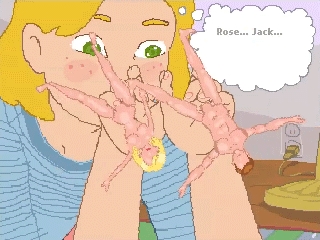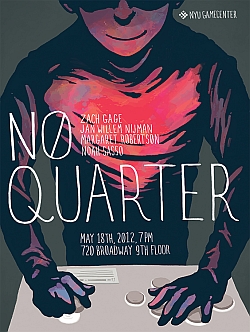
Day two of IndieCade 2014 was nonstop action and fun. There was an area sectioned off from 11:00 AM to 6:00 PM for “Show & Tells,” where developers could show off unreleased games and conference-goers could playtest prototypes. There were dozens of amazing games to check out, and that’s just what we did.
Pixeljam Games, the mad geniuses behind Dino Run, were there showing off their latest game, Glorkian Warriors. A Mario-like platformer meets a Galaga-like shooter in the vibrant chaos of a trippy cartoon in this fast-paced shoot-‘em-up for mobile devices. Control your Glork’s movements from left to right by tapping the edges of the screen (what they refer to as “Edge Technology”), and tap higher to make him jump. As you move around, you shoot the crazy space monsters that are coming down and shooting at you. Kill them, collect their delicious crackers, and avoid exploding basketballs. It’s a blast!
Earth Knight was there as well, and despite having seen it at the Philly Game Forge’s Game Showcase back in November, I didn’t get a chance to play it until this weekend. In this visually stunning game made by Philly-based Cleaversoft, you run across the back of a dragon flying high in the air, collecting power-ups and jumping over – and onto – monsters. I played it with a USB-NES controller, and only used two buttons – A to jump, and left on the directional pad to “anchor,” which makes you come down from your jump faster. You’re always running. If you pick up the sword power-up, you can then jump into some monsters that are hovering in the air and slash them, making it easier to take them out. Once you get to the dragon’s head, you stab it repeatedly, and then dive off of him and towards the Earth. Beneath you are dozens more dragons, and you must land on one to repeat the process again.
 There were also some great games that were made at various game jams. How Do You Do It was made at this year’s Global Game Jam. The theme was “We don’t see things as they are, we see things as we are.” Emmett Butler, Nina Freeman, and Jonathan Kittaka made a game in which you play as a small girl who saw her parents having sex, and tries to recreate their actions with her dolls. She holds their limp bodies, and you are in control of the position of the dolls as well as how far apart they are from one another. You mash them together to have sex, and at the end, you’ll get a tally of how many times you “made sex.” While you’re doing that, the little girl’s quirky, child-like thoughts pop up on the screen. If you hear your mom coming, you can hide the dolls, but if you don’t hide them in time, she catches you. It’s a fun, sweet, and hilarious game, and it captured the theme of the jam perfectly.
There were also some great games that were made at various game jams. How Do You Do It was made at this year’s Global Game Jam. The theme was “We don’t see things as they are, we see things as we are.” Emmett Butler, Nina Freeman, and Jonathan Kittaka made a game in which you play as a small girl who saw her parents having sex, and tries to recreate their actions with her dolls. She holds their limp bodies, and you are in control of the position of the dolls as well as how far apart they are from one another. You mash them together to have sex, and at the end, you’ll get a tally of how many times you “made sex.” While you’re doing that, the little girl’s quirky, child-like thoughts pop up on the screen. If you hear your mom coming, you can hide the dolls, but if you don’t hide them in time, she catches you. It’s a fun, sweet, and hilarious game, and it captured the theme of the jam perfectly.
Over in the PlayStation area, we noticed a new addition – a laptop was set up at a small table in the back. Wandering over to it, we saw that Galak-Z, one of our PAX Prime 2013 “PAXpocalypse” selections, was quietly running with a DualShock 4. I hadn’t gotten to play it at PAX, so I took some time to try it out. While the controls are tough to get used to – you use R1 to boost, and the directional buttons to aim your ship – once you’ve played it a little while, it becomes highly intuitive and very fun.
With the majority of the crowd playing games downstairs, we took some time to sneak back upstairs to the Essential Indies installation and play more. I had a great time playing Everyday Shooter, a twin-stick shooter game that came out in 2007 on the PlayStation 3. You shoot enemies around you, and instead of hearing the typical explosions and other sound effects, there are guitars strumming and other soothing musical instruments.
I also checked out Howling Dogs, part of Porpentine’s Twine Compilation. Twine is a program that creates text adventures, and in Howling Dogs, you are trapped in some sort of prison, in which your only real option is to take drugs and enter a virtual reality. I tried to escape, but as it lead me deeper down the rabbit hole, I started to forget to do the basic things, and my room became filthy. It was a disturbing and haunting experience – despite the fact that I was in a museum full of people, while I had the headphones on, I felt like I was trapped within the game.
As with the first day of IndieCade, the second day also had plenty of talks. There were talks about how much detailed work goes into video games (“Black Mesa Source: Makeover Xtreme”), a talk by Code Liberation Foundation that encourages women to get into game development (“Encouraging Women in Game Development through Community, Education, and Development”), and the day wrapped up with a keynote by Auriea Harvey. In her talk, Harvey was very candid about her relationship with her husband, Michael Samyn, with whom she makes video games. Her keynote, entitled “Let’s Make a Video Game! A Tale in Ten Incantations,” offered “ten astounding, confusing, beautiful, sublime, painful, true, ineffable, raw, believable, and unbelievable ways of seeing what she calls an art form at the end of history.” There were more workshops on Saturday as well – a sort of postmortem on Flappy Bird, a workshop on openFrameworks, and an IndieCade Town Hall.
 I enjoyed Charles Pratt’s talk, “The No Quarter Exhibition: A Brief History.” Pratt is the curator of No Quarter, which was basically an experiment in creating “indie games for multiple people in a social setting,” and may be the birthplace of today’s rich local multiplayer selection. With games like Nidhogg, Hokra, and Killer Queen made for No Quarter, it’s easy to see that it’s had influence on games like TowerFall, Samurai Gunn, and so many others. Pratt approaches developers and pays them to create games for No Quarter each year, which he feels helps to make games that would not have been made otherwise. “We’re asking people to make games no one might every play again, which is risky,” Pratt said. And that is why they pay them – to incentivize them to take the risks, to “just do something weird and interesting… When you’re not worried about the market, it is easier to be creative and experimental.” I felt like I learned so much, not just about the local New York indies scene, but about the history of a game genre I love so much right now: local multiplayer.
I enjoyed Charles Pratt’s talk, “The No Quarter Exhibition: A Brief History.” Pratt is the curator of No Quarter, which was basically an experiment in creating “indie games for multiple people in a social setting,” and may be the birthplace of today’s rich local multiplayer selection. With games like Nidhogg, Hokra, and Killer Queen made for No Quarter, it’s easy to see that it’s had influence on games like TowerFall, Samurai Gunn, and so many others. Pratt approaches developers and pays them to create games for No Quarter each year, which he feels helps to make games that would not have been made otherwise. “We’re asking people to make games no one might every play again, which is risky,” Pratt said. And that is why they pay them – to incentivize them to take the risks, to “just do something weird and interesting… When you’re not worried about the market, it is easier to be creative and experimental.” I felt like I learned so much, not just about the local New York indies scene, but about the history of a game genre I love so much right now: local multiplayer.
At 7:00 PM, the fun was just beginning. Night Games took over the museum, with everything from LARPs, to live-action games, to games on massive screens. The first thing we did was head right to the second floor to play some Crypt of the Necrodancer, which was set up on two dance pads for cooperative play. Anthony Amato and I couldn’t get near this game at PAX Prime on anything but the keyboard, so I was thrilled to be able to play it, even if it meant I had to fumble around in front of a room full of people watching us. The game felt amazing – you have to move on the pad in time with the music in the direction you want to go. Moving with the music builds up your multiplier, and also helps you kill monsters, who sometimes come barreling through walls (damn you, Minotaur!).
Afterwards, we were interviewed by part of the Brace Yourselves Games team for their Kickstarter video. I was thrilled to hear that they’ll be doing a Kickstarter, not for the game, but for the game pad, which was the only thing stopping me from not buying the game in the first place. Once that Kickstarter launches, I’m definitely backing it – which I’m sure my neighbors who live under me are going to just love.
Tenya Wanya Teens was another amazing game that we played during Night Games. Created with two custom 16-button gamepads with LEDs under each button, Tenya Wanya Teens takes you and a partner through a series of commands. You are two small boys, and you enter the first room and must do something simple, like pee in a urinal, or rock out at a microphone. The game tells you to hit the red button to do this. Half the buttons light up red, so it’s easy to mash one down. But as the game progresses, the commands become more complicated (you might have to rock out and pee on the same screen), and the buttons change color, so you end up confessing love to the other player, or getting naked in front of the girl you like. (I actually said the words, “I’m so sorry, but I’m going to pee on you!” to a complete stranger.) It was amazing.
We played a few more games, including Zombie Ward, a live-action zombie game played with eight people and some boxes, and Surround, a fast-paced local multiplayer tactical video game. Anthony even checked out the Grasshopper Round Table, a custom-built touch table for up to six people, on which they were running a handful of indie games. We ended the night as you might expect… we dragged all of our Philadelphia friends upstairs to the Killer Queen Arcade and had a hilarious, knock-down, drag-out battle until it was time to go.
Day 1 | Day 2 | Day 3







